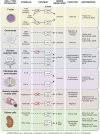Tonicity-independent regulation of the osmosensitive transcription factor TonEBP (NFAT5)
- PMID: 21998140
- PMCID: PMC3328893
- DOI: 10.1152/ajpcell.00327.2011
Tonicity-independent regulation of the osmosensitive transcription factor TonEBP (NFAT5)
Abstract
Tonicity-responsive enhancer binding protein (TonEBP/nuclear factor of activated T-cells 5 [NFAT5]) is a Rel homology transcription factor classically known for its osmosensitive role in regulating cellular homeostasis during states of hypo- and hypertonic stress. A recently growing body of research indicates that TonEBP is not solely regulated by tonicity, but that it can be stimulated by various tonicity-independent mechanisms in both hypertonic and isotonic tissues. Physiological and pathophysiological stimuli such as cytokines, growth factors, receptor and integrin activation, contractile agonists, ions, and reactive oxygen species have been implicated in the positive regulation of TonEBP expression and activity in diverse cell types. These new data demonstrate that tonicity-independent stimulation of TonEBP is critical for tissue-specific functions like enhanced cell survival, migration, proliferation, vascular remodeling, carcinoma invasion, and angiogenesis. Continuing research will provide a better understanding as to how these and other alternative TonEBP stimuli regulate gene expression in both health and disease.
Figures

Similar articles
-
NFAT5/TonEBP mutant mice define osmotic stress as a critical feature of the lymphoid microenvironment.Proc Natl Acad Sci U S A. 2004 Jul 20;101(29):10673-8. doi: 10.1073/pnas.0403139101. Epub 2004 Jul 9. Proc Natl Acad Sci U S A. 2004. PMID: 15247420 Free PMC article.
-
Calcineurin-NFATc signaling pathway regulates AQP2 expression in response to calcium signals and osmotic stress.Am J Physiol Cell Physiol. 2007 May;292(5):C1606-16. doi: 10.1152/ajpcell.00588.2005. Epub 2006 Dec 13. Am J Physiol Cell Physiol. 2007. PMID: 17166937
-
Phosphorylation by casein kinase 1 regulates tonicity-induced osmotic response element-binding protein/tonicity enhancer-binding protein nucleocytoplasmic trafficking.J Biol Chem. 2008 Jun 20;283(25):17624-34. doi: 10.1074/jbc.M800281200. Epub 2008 Apr 14. J Biol Chem. 2008. PMID: 18411282 Free PMC article.
-
The role of NFAT5/TonEBP in establishing an optimal intracellular environment.Arch Biochem Biophys. 2003 May 15;413(2):151-7. doi: 10.1016/s0003-9861(03)00130-9. Arch Biochem Biophys. 2003. PMID: 12729611 Review.
-
Extracellular osmolarity regulates matrix homeostasis in the intervertebral disc and articular cartilage: evolving role of TonEBP.Matrix Biol. 2014 Nov;40:10-6. doi: 10.1016/j.matbio.2014.08.014. Epub 2014 Aug 27. Matrix Biol. 2014. PMID: 25172826 Free PMC article. Review.
Cited by
-
NFAT5 participates in seawater inhalation‑induced acute lung injury via modulation of NF-κB activity.Mol Med Rep. 2016 Dec;14(6):5033-5040. doi: 10.3892/mmr.2016.5860. Epub 2016 Oct 19. Mol Med Rep. 2016. PMID: 27779669 Free PMC article.
-
Multiscale Regulation of the Intervertebral Disc: Achievements in Experimental, In Silico, and Regenerative Research.Int J Mol Sci. 2021 Jan 12;22(2):703. doi: 10.3390/ijms22020703. Int J Mol Sci. 2021. PMID: 33445782 Free PMC article. Review.
-
NFAT5 expression in bone marrow-derived cells enhances atherosclerosis and drives macrophage migration.Front Physiol. 2012 Aug 3;3:313. doi: 10.3389/fphys.2012.00313. eCollection 2012. Front Physiol. 2012. PMID: 22934063 Free PMC article.
-
Copper oxide nanoparticle toxicity profiling using untargeted metabolomics.Part Fibre Toxicol. 2016 Sep 8;13(1):49. doi: 10.1186/s12989-016-0160-6. Part Fibre Toxicol. 2016. PMID: 27609141 Free PMC article.
-
TonEBP expression is essential in the IL-1β-induced migration and invasion of human A549 lung cancer cells.Oncol Res. 2023 Nov 15;32(1):151-161. doi: 10.32604/or.2023.030690. eCollection 2023. Oncol Res. 2023. PMID: 38188678 Free PMC article.
References
-
- Adachi A, Niijima A, Jacobs HL. An hepatic osmoreceptor mechanism in the rat: electrophysiological and behavioral studies. Am J Physiol 231: 1043–1049, 1976 - PubMed
-
- Adrogue HJ, Madias NE. Hypernatremia. N Engl J Med 342: 1493–1499, 2000 - PubMed
-
- Baumgarten M, Bloebaum RD, Ross SD, Campbell P, Sarmiento A. Normal human synovial fluid: osmolality and exercise-induced changes. J Bone Joint Surg Am 67: 1336–1339, 1985 - PubMed
Publication types
MeSH terms
Substances
Grants and funding
LinkOut - more resources
Full Text Sources

